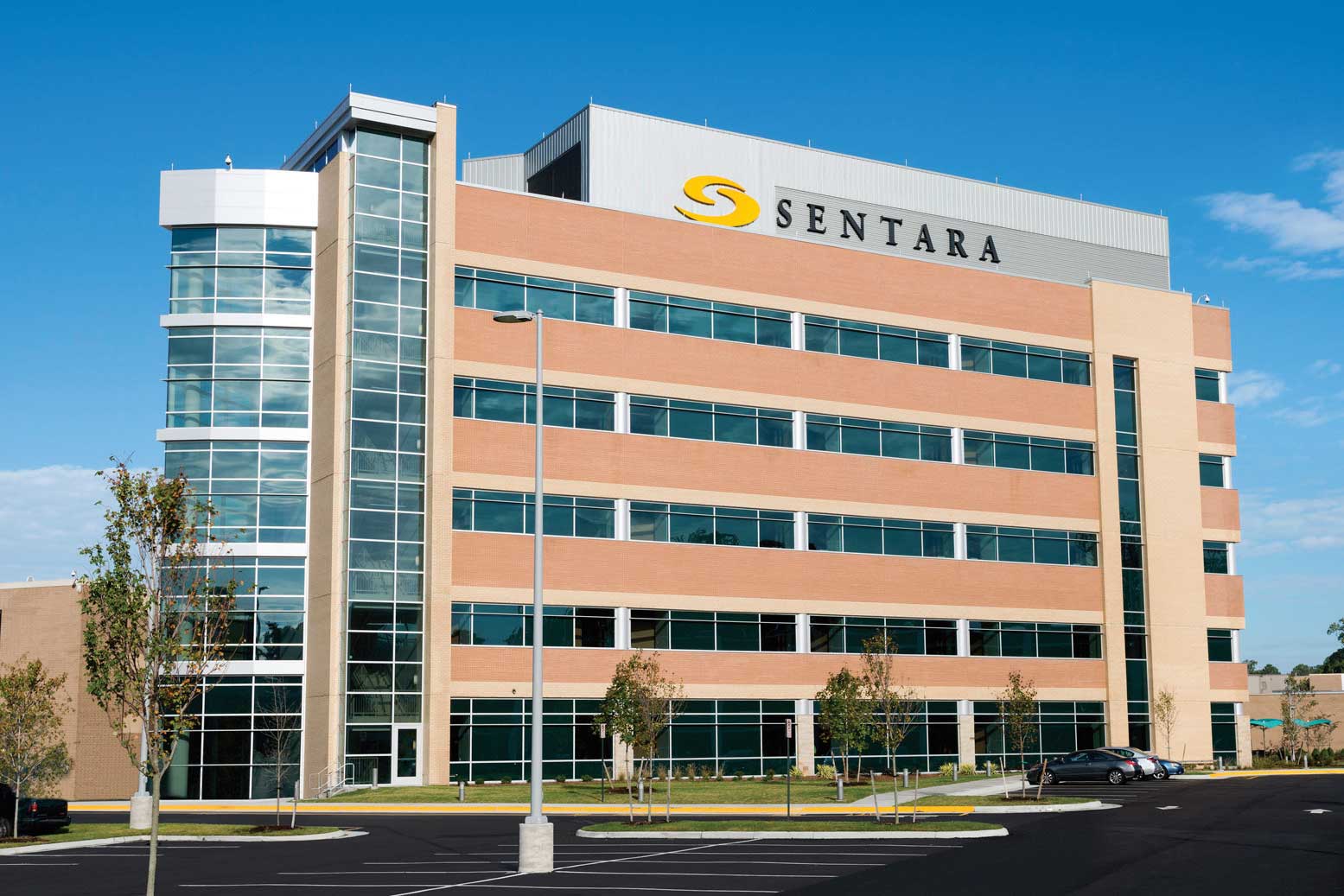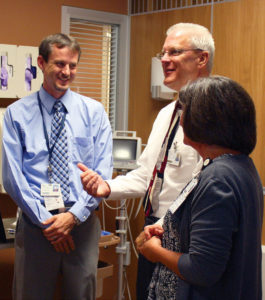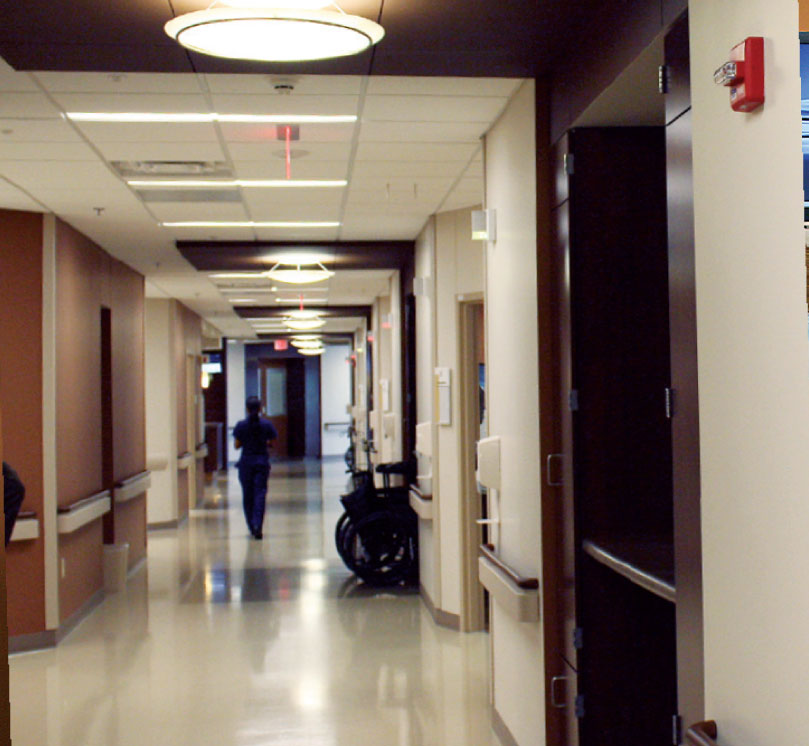A Focus on Family to Create a Healing Environment
Responder® 5 Solution Helps Drive Noise Reduction;
Fast, Direct Communications; and a Sense of Empowerment for Families

Considerable research demonstrates how support from family and close friends can create a more healing environment for patients. Providing those friends and families a certain sense of control can significantly decrease stress and improve satisfaction for both families and the patient.
Sentara Leigh Hospital in Norfolk, Virginia, is encouraging and promoting social support for its patients with a specially designed Responder® 5 nurse call solution used across two new Med/Surg towers. In its roll-out of Responder 5 in patient rooms, the hospital customized a unique work ow screen just for families that considers their needs and gives them direct, one-touch communication with providers and ancillary staff for requests.
“Our goal is to involve and empower families in the patient’s care, with work ow processes created to speed responses, improve satisfaction and reduce noise,” said Jennifer Kreiser, VP Nurse Executive.

NURSE CALL: A CLINICAL APPLICATION
A 250-bed hospital, Sentara Leigh is in construction on a modernization and expansion plan to create an innovative, state-of-the-art facility. Two new patient towers feature private bathrooms, no-step showers and overnight accommodations for families.
“Our modernization here at Sentara is addressing a general change in healthcare as it relates to nurse call,” said Betsy Meadows, Director, Network Enterprise Services for Sentara Healthcare.
“It’s no longer just lights and pullcords. We’ve taken the stance that it is a facility-wide system, a true clinical system, and we are treating it that way in our modernization and expansion.”
Responder nurse call is in use throughout the facility, including pillow speakers, patient stations and more than 200 Responder work ow terminals integrated to staff RTLS badges and mobile phones. The workflow terminals automate processes for nursing and staff, with one button press sending alerts and notifications across the hospital, including rounding and pain & reassessment reminders for caregivers. The system speeds responses, strengthens workflows, reduces noise and helps increase staff and patient satisfaction.
Already standardized on the Responder 5 solution, technology staff looked at the expansion as an opportunity to identify the capabilities of the technology and look at new ways it could be used to improve clinical processes.
FAMILY INVOLVEMENT
“Responder was already addressing the workflows of providers and ancillary staff,” said Matt Montcrieff, Business System Application Analyst, “but a multidisciplinary team including bedside providers brainstormed additional processes that could be addressed, and presented options to clinicians that led to answering the needs of families visiting patients.”
“Very often a family member is in the room in need of assistance but doesn’t want to bother a nurse,” Montcrieff said. “Giving them some control, without the need to stand in the hallway or wait for a provider, greatly reduces their stress and allows things to be done automatically without lots of unneeded steps.”
“Our goal is to involve and empower families in the patient’s care, with workflow processes created to speed responses, improve satisfaction and reduce noise.”
Jennifer Kreiser, VP Nurse Executive
As a result, Sentara customized its work ow stations in Med/Surg units with a special screen specifically designed for family members, with buttons that route requests to the correct level of assistance based upon need. The system gives control to those family members sitting in the patient’s room, said Kreiser, and the special screen addresses what a family typically needs or requests.
- A row of red buttons alerts nursing to the patient’s need related to toilet or pain.
- A row of yellow buttons are directed to nursing assistants for simple requests, like a blanket or water, which decreases interruptions to the nursing staff.
- A row of green buttons makes requests to other departments, the Chaplin or to the patient advocate with a simple button press.

“Families are impressed with the technology and how it improves the safety of our patients,” added Kreiser. “They like that they can make a request to the right care provider, and not always interrupt the nurse.”
MED/ADMIN TIME OUT
“Adding specific care need options on the work ow stations mean more needs can get routed to the service provider automatically,” said Kreiser.
A catalyst in installing Responder 5 across the facility, she points out, was the ability to get notifications and requests to the right person at the right time.


In designing the Family screen, Sentara added a special button for nursing called ‘Med/Admin.’ With a touch of this button, a nurse can get up to 15 minutes of uninterrupted time to discuss the plan of care with a patient, or to administer medications. During this interval, all calls to the nurse are silenced and re-routed to other staff, and a corridor light illuminates to notify others that the nurse is in consultation in the room.
Sentara also synchronized alerts and notifications to the corridor lights outside each room, so that nursing could immediately triage the patient need right from the hallway without going to each room. Special colored lights and combinations notify staff of specific high risks for each patient — including falls, difficult airway or high skin risk — without the need to place magnets or signs to the doors or hallway that can raise the risk of infection.
Text pages remind the staff to hourly round or to reassess the pain medication response.
IMPROVED SATISFACTION
The rst thing you notice using the Responder system is how silent the unit is, according to Willow Golay, Clinical Manager at Sentara.
“Noise reduction has been a key driver across all of our units,” Golay said, “to improve the overall environment and maintain a quiet oor at night. Using Responder 5, we no longer need to drive that, as Responder sends all of our calls directly to the staff’s phones, resulting in a silent worflow.”
“This puts wonderful technology at our fingertips,” Golay added. “I don’t walk as much, and there are fewer interruptions to the clinical staff. We’re seeing much greater ef ciencies and getting a faster response — when you are able to call the speci c staff you need care from. We no longer have two or three people on the unit responding to the same call, and we’re getting fewer distractions as we deliver care.”
IMPROVED SCORES WITH RESPONDER
Call response has improved by 32 percent, according to Sentara, in a short period of time once the unit transitioned to the Responder 5 system. The hospital also reports a 45 percent improvement in scoring to the question ‘Was it quiet outside your room at night,” because the patients are not hearing call bells and paging going off at night across the unit, said Golay.
TECHNOLOGY ROADMAP
“We’ve placed a strong emphasis on using technology to benefit clinical needs,” said Greg Walkup, Director – Information Technologies Enterprise Application Services, “resulting in better care, better ef ciencies and patient safety.” At Sentara Leigh, he added, every clinical base has an IT support staff assigned to them.
Sentara chose to standardize on Responder 5 for healthcare communications following a review of vendors, because Responder met all of their current and future requirements, according to Walkup.
“It gives us a stable, reliable system,” Walkup said, “and the functionality meets clinical requirements for escalations, workflows, corridor lights, as well as reporting on staff/patient activity. We reviewed the technology with clinical staff to ensure it was going to be comprehensive, and by standardizing on Responder we are also seeing efficiencies in training and staffing.”
“The decision was easy to stay with Responder,“ Walkup added. “We’ll be applying the same technology and the same workflows in all locations.”
“Our goal now is to gain system-wide reporting and establishment of best practices that can be applied across all of our facilities,” Meadows said.
